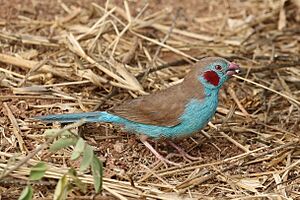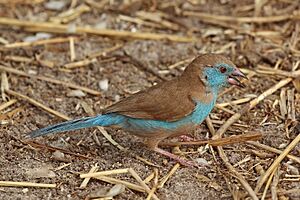Red-cheeked cordon-bleu facts for kids
Quick facts for kids Red-cheeked cordon-bleu |
|
|---|---|
 |
|
| male U. b. bengalus | |
 |
|
| female U. b. bengalus both in Gambia |
|
| Conservation status | |
| Scientific classification |
The red-cheeked cordon-bleu (Uraeginthus bengalus) is a small, colorful bird. It belongs to a group of birds called passerines, which are often known as "perching birds." This bird is part of the Estrildidae family, which includes many types of finches.
You can find the red-cheeked cordon-bleu living in dry areas of tropical Sub-Saharan Africa. It's a common bird that stays in these regions all year round. Its home covers a huge area, about 7.7 million square kilometers!
Contents
What's in a Name?
The red-cheeked cordon-bleu got its name from a mistake! In 1760, a French zoologist named Mathurin Jacques Brisson described this bird. He thought it came from a place called Bengal. Because of this, he gave it the Latin name Bengalus.
Later, in 1766, a famous Swedish scientist named Carl Linnaeus officially named the bird Fringilla bengalus. The "bengalus" part still came from the idea that it was from Bengal. However, scientists later found out that the bird actually came from Senegal, not Bengal! Today, this bird is placed in the group (genus) called Uraeginthus.
There are four slightly different types of red-cheeked cordon-bleus, called subspecies. They mostly look different in how much blue the females have on their faces and bellies.
- U. b. bengalus: Found from Mauritania to Ethiopia and Uganda.
- U. b. brunneigularis: Lives in Somalia, Kenya, and Tanzania.
- U. b. ugogensis: Found in Kenya and Tanzania.
- U. b. katangae: Lives in Angola, Democratic Republic of the Congo, and Zambia.
How to Spot a Red-Cheeked Cordon-Bleu
This finch is quite small, usually about 12.5 to 13 centimeters (about 5 inches) long. It weighs around 9.9 grams, which is about the same as two nickels!
The male red-cheeked cordon-bleu is easy to recognize. It has brown feathers on its back and a light blue chest, sides, and tail. Its belly is yellow. The most special part is the bright red patch on each cheek. Sometimes, this patch can look orange or even yellow.
Female birds look similar to males but are not as brightly colored. They also do not have the red cheek spots. Young birds look like females, but they only have blue on their face and throat.
What Does It Sound Like?
When these birds talk to each other, they make a thin, high-pitched sound. It often sounds like "siii siii" or "tsee tsee."
Their song is more complicated. It has 4 to 6 high-pitched notes. The last note is longer and lower. People describe it as "rhythmic but lazy." It might sound like "wit-sit-diddley-diddley-ee-ee."
Unlike many other songbirds, female red-cheeked cordon-bleus also sing! They sing to help keep their mate close and to get ready for breeding. They also help protect their nest area.
Where Do They Live?
The red-cheeked cordon-bleu is very common across central and eastern Africa. You can find them from countries like Senegal and Gambia in West Africa, all the way east to Ethiopia and Somalia. They also live south into countries like the Democratic Republic of the Congo and Tanzania.
These birds live in almost all types of places, except for deep inside forests. They can be found from sea level up to high elevations, around 2,430 meters (about 7,970 feet) high.
They have also been brought to the Hawaiian Islands of Hawaii and Oahu. Sometimes, they are seen in other places, but these are usually birds that have escaped from cages.
Daily Life and Food
You will often see red-cheeked cordon-bleus in open, dry grasslands and savannas. They also like to be around places where people live.
What Do They Eat?
Red-cheeked cordon-bleus mainly eat seeds, especially grass seeds. They also enjoy eating millet and other small seeds. Sometimes, they even eat beeswax!
Bigger birds, like the pin-tailed whydah, might try to chase cordon-bleus away from food. This makes it harder for the smaller cordon-bleus to find enough to eat.
Reproduction and Nests
When it's time to build a nest, the red-cheeked cordon-bleu makes a large, dome-shaped structure out of grass. It has an entrance on the side. They build these nests in trees, bushes, or even in thatched roofs. The female bird will lay 4 to 5 white eggs inside.
Red-Cheeked Cordon-Bleus as Pets
Many people enjoy keeping red-cheeked cordon-bleus as pets. They are known as one of the most popular "exotic finches." They don't need special cages, but they do need to be kept warm. This is because they often sleep on open branches instead of inside a cozy nest.
During the breeding season, male cordon-bleus can become very aggressive towards each other if they are kept together. Also, if a bird is disturbed while sitting on its eggs, it might leave the nest.
Gallery
-
Female in Kenya





